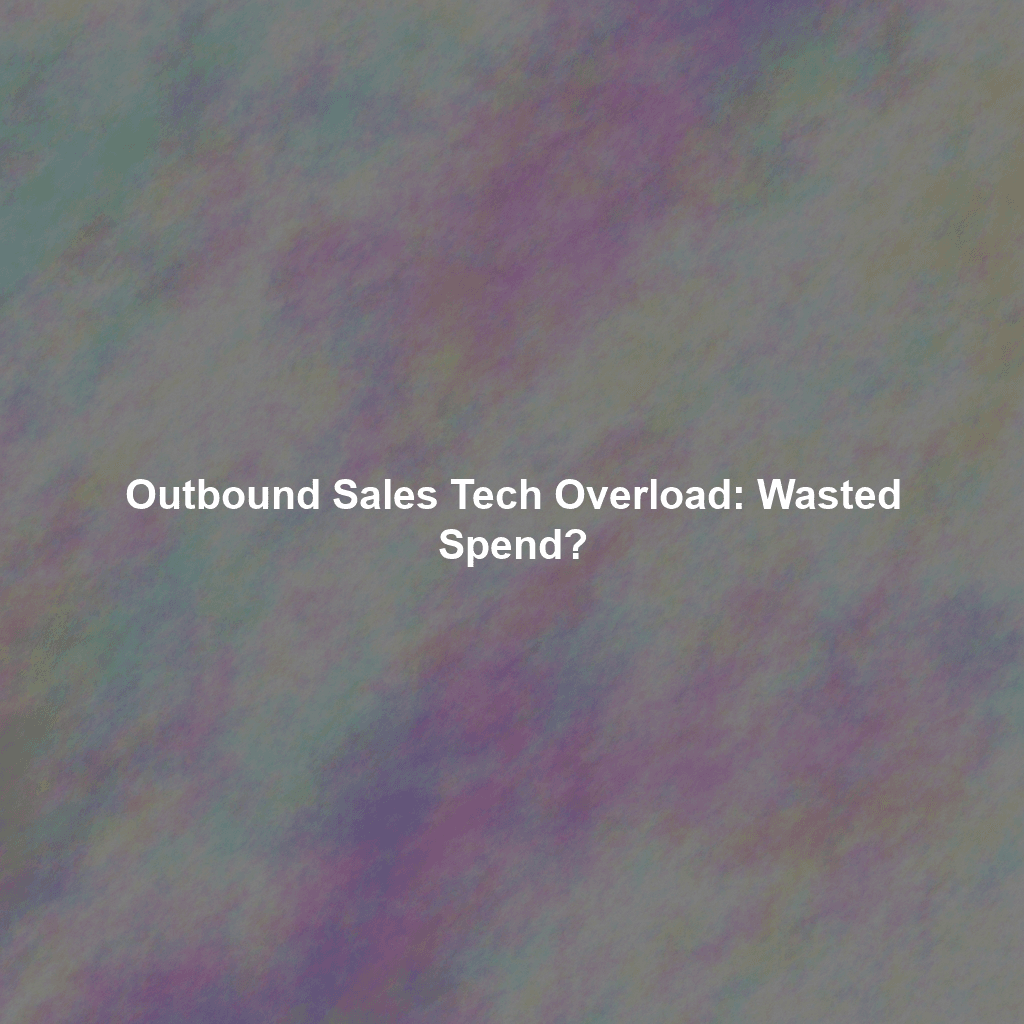In today’s B2B landscape, outbound sales, while still valuable, is facing headwinds. Email open rates are declining, cold calling is increasingly perceived as intrusive, and buyers are more informed and less receptive to generic pitches. One often overlooked contributor to this decreasing effectiveness is the very thing intended to improve it: the sales technology stack. Have you found yourself swimming in a sea of CRM systems, prospecting tools, automation platforms, and analytics dashboards, all promising to boost your outbound efforts, yet somehow… the results are underwhelming? You’re not alone. The problem isn’t the idea of using technology, but the execution and, more specifically, the potential for technology overload.
The Paradox of Choice: How Too Much Tech Hurts Outbound Sales
We’ve all been there. Driven by the fear of missing out (FOMO), or persuaded by slick marketing promising exponential growth, companies rapidly accumulate sales tools. Each platform promises to solve a specific pain point, from lead generation to automated follow-ups. However, this unchecked proliferation of technology often leads to a counterintuitive outcome: a decrease in outbound sales effectiveness. Why?
Information Overload and Analysis Paralysis
Sales reps are already juggling multiple tasks. Bombarding them with data from numerous disparate platforms creates a cognitive overload. They spend more time switching between tools, deciphering data, and manually integrating information than actually engaging with prospects. This “analysis paralysis” prevents them from focusing on what truly matters: building relationships and understanding customer needs.
Decreased Adoption and Skill Gaps
Introducing too many tools too quickly can overwhelm even the most tech-savvy sales teams. Reps may struggle to learn and effectively utilize each platform, leading to inconsistent usage or outright abandonment. The resulting data gaps further compromise the accuracy of any analysis and prevent you from making informed decisions. Moreover, the time spent learning new tools eats into valuable selling time. This is especially true when onboarding doesn’t keep pace with product updates.
Integration Nightmares and Data Silos
A fragmented tech stack creates data silos. Information resides in separate platforms, making it difficult to get a holistic view of the customer journey. Incomplete or inaccurate data hinders personalization and prevents reps from delivering targeted and relevant messages. Integrating these disparate systems can be complex and expensive, often requiring specialized IT support.
Recognizing the Signs of Tech Stack Overload
How do you know if your outbound sales tech stack is doing more harm than good? Look for these warning signs:
- Low tool adoption rates: Are reps actively using all the tools in your stack?
- Decreasing outbound sales metrics: Are open rates, click-through rates, and conversion rates declining?
- Increased sales cycle length: Is it taking longer to close deals?
- Rep frustration and complaints: Are sales reps expressing frustration with the complexity of the tech stack?
- Duplicate data entries: Is your CRM riddled with redundant or conflicting information?
- Difficulty measuring ROI: Are you struggling to track the effectiveness of individual tools?
Taming the Tech Stack: A Practical Approach
Don’t despair! You can reclaim control and optimize your outbound sales tech stack to drive results. Here’s a structured approach:
1. Audit Your Current Tech Stack
Begin with a comprehensive audit of your existing tools. List every platform you’re using, its intended purpose, its cost, and who is using it. Conduct interviews with your sales team to understand their experiences with each tool. Identify redundant features or functionalities that overlap across multiple platforms.
2. Identify Redundant and Underutilized Tools
Based on your audit, identify tools that are underutilized or have overlapping functionality. Are you paying for features that no one is using? Are there tools that could be consolidated or replaced? Consider sunsetting tools that are providing minimal value or are consistently met with resistance from your sales team.
3. Prioritize Integration and Automation
Focus on integrating your core sales tools to create a seamless workflow. Prioritize integrations between your CRM, prospecting tools, and marketing automation platforms. Automate repetitive tasks, such as data entry, lead routing, and follow-up emails. This will free up your sales reps to focus on building relationships and closing deals.
4. Streamline Processes and Training
Review your sales processes and identify areas where technology can improve efficiency. Develop clear standard operating procedures (SOPs) for each tool. Provide comprehensive training to ensure your sales team understands how to use the technology effectively. Regular training sessions can help reinforce best practices and address any knowledge gaps.
5. Measure ROI and Track Performance
Establish clear metrics to measure the ROI of each tool in your tech stack. Track key performance indicators (KPIs) such as lead generation, conversion rates, sales cycle length, and revenue generated. Regularly analyze the data to identify areas for improvement and make data-driven decisions about your tech stack. Consider A/B testing different tools or workflows to optimize performance.
6. Embrace a “Less is More” Mentality
Resist the urge to constantly add new tools to your stack. Instead, focus on maximizing the value of the tools you already have. Prioritize quality over quantity. A well-integrated and effectively utilized stack of fewer tools will often outperform a sprawling, fragmented collection of platforms.
The Human Element: Don’t Forget the People
Technology is a tool, not a silver bullet. Even the most sophisticated tech stack will fail if your sales team isn’t equipped with the skills and knowledge they need to succeed. Invest in training and coaching to develop your reps’ communication, relationship-building, and closing skills. Remember that technology should augment human interaction, not replace it entirely. The best outbound sales strategies combine the power of technology with the art of human connection.
 Skip to content
Skip to content

